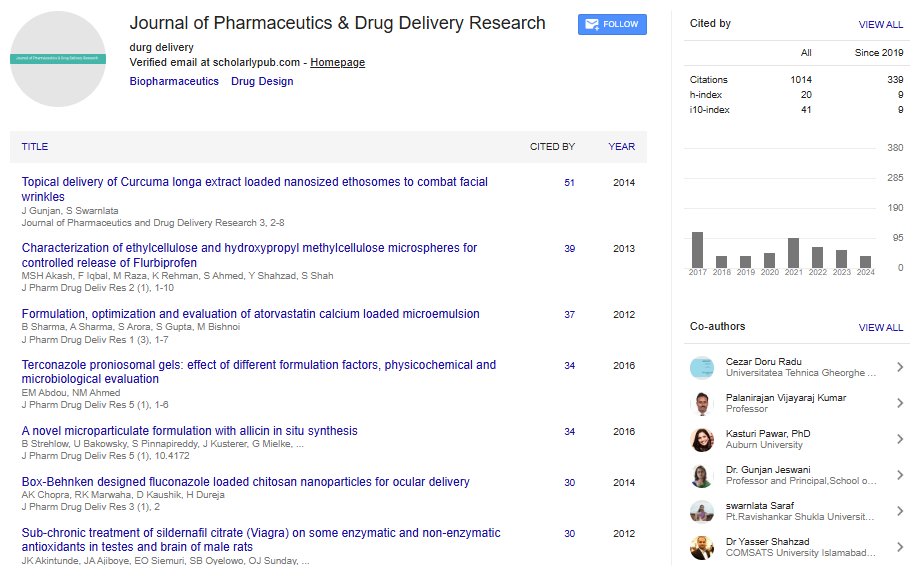Commentary, J Pharm Drug Deliv Res Vol: 13 Issue: 6
Innovative Techniques in Drug Design and its Applications
Wang Feng*
1Department of Pharmaceutical Science, Nanjing University, Nanjing, China
*Corresponding Author: Adamantia Nikolaidi, Oncology Clinic
Department of Pharmaceutical Science,
Nanjing University, Nanjing, China
E-mail: fen.wan@gmail.com
Received date: 28 October, 2024, Manuscript No. JPDDR-24-154163;
Editor assigned date: 30 October, 2024, PreQC No. JPDDR-24-154163 (PQ);
Reviewed date: 13 November, 2024, QC No. JPDDR-24-154163;
Revised date: 20 November, 2024, Manuscript No. JPDDR-24-154163 (R);
Published date: 29 November, 2024, DOI: 10.4172/2325-9604.1000311
Citation: Feng W (2024) Innovative Techniques in Drug Design and its Applications. J Pharm Drug Deliv Res 13:6.
Description
Drug design is a multidisciplinary field that can be found at the intersection of chemistry, biology, pharmacology and computational science. It is the process of discovering and developing new medications by understanding the biological mechanisms of diseases and personalizing molecules to interact with specific targets. Modern drug design has been revolutionized by advancements in technology and molecular biology, providing more efficient and specific methods to create effective therapeutics.
Basics of drug design
Drug design involves a thorough understanding of the disease pathology, biological targets and the chemical nature of potential therapeutic agents. The process can be broadly categorized into two main approaches.
Structure-Based Drug Design (SBDD): SBDD involves developing medications based on the three-dimensional structure of a biological target. This technology uses X-ray crystallography and Nuclear Magnetic Resonance (NMR) spectroscopy to visualize target structures. Using this information, computational tools can design molecules that Serve properly into the target's main location.
Ligand-Based Drug Design (LBDD): LBDD depends on the knowledge of molecules that have previously shown activity against the target. By analyzing the Structure-Activity Relationship (SAR) of these ligands, investigators can design new compounds with improved efficacy and reduced side effects.
Both methods aim to create molecules with high specificity, optimal pharmacokinetics and minimal toxicity.
Computational tools in drug design
These are common computational tools in drug design. Molecular docking determines how the medicinal molecule will associate to its target. This tool helps to assess the interaction strength and binding affinity, guiding the selection of potential candidates. A pharmacophore is the physical arrangement of characteristics that enable a drug to communicate with its intended patient. This model helps in identifying and designing molecules with desired biological activity. Quantitative Structure-Activity Relationship (QSAR) models establish correlations between the chemical structure of compounds and their biological activity. These models allow for the effects of new compounds. Molecular Dynamics (MD) simulations provide insights into the dynamic behavior of drug-target interactions over time. This simulation helps to improve drug candidates by evaluating their stability and structural changes.
Techniques in modern drug design
Major techniques used in modern drug design including. Fragment- Based Drug Design (FBDD) involves using small chemical fragments that associate poorly to the target. These individual components are optimized and combined to produce powerful therapeutic candidates. This method has been successful in developing drugs such as vemurafenib for melanoma. Structure-Activity Relationship (SAR) studies identify chemical modifications that enhance activity and selectivity. Iterative SAR cycles allow the systematic refinement of lead compounds. Targeted protein degradation technique involves designing molecules that promote the degradation of disease-causing proteins. Proteolysis-Targeting Chimeras (PROTACs) are a significant example, providing a new treatment option for illnesses that had been considered to be fatal.
Applications of drug design
Modern drug designs are commonly utilized for the following applications.
Cancer therapy: Targeted therapies designed to inhibit specific cancer genes have revolutionized cancer treatment. Drugs including imatinib for chronic myeloid leukemia exemplify the success of rational drug design in oncology.
Infectious diseases: Drug design has been instrumental in developing antiviral agents such as oseltamivir for influenza and antiretroviral therapies for HIV. Structure-based methods have facilitated the design of inhibitors targeting viral enzymes.
Neurological disorders: Designing drugs to cross the Blood-Brain Barrier (BBB) remains a challenge. Advances in understanding BBB permeability and transporter mechanisms have led to the development of Central Nervous System (CNS)-active drugs for conditions such as Alzheimer’s and Parkinson’s diseases.
 Spanish
Spanish  Chinese
Chinese  Russian
Russian  German
German  French
French  Japanese
Japanese  Portuguese
Portuguese  Hindi
Hindi 
